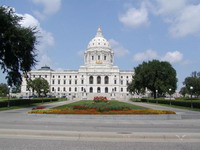Login form
Minnesota

Paul Bunyan was a giant lumberjack. When he stood up he could see all of Minnesota. He could see vast prairies to the west and south. He could see the huge forests to the north and east. Paul had a giant blue ox named Babe. One day Babe ran away, and Paul chased the ox all over Minnesota. They left thousands of giant footprints across the state. It rained heavily, and the footprints became lakes.
The legend of Paul Bunyan and Babe the Blue Ox is well known in Minnesota. Forests once covered two-thirds of the state, and thousands of lumberjacks came to Minnesota to cut timber. At night, they told stories about Paul and Babe to explain the land and climate of Minnesota’s northern woods.
|
Facts About Minnesota |
|
|
|
|
|
Capital |
Saint Paul |
|
Population |
5,060,000 people |
|
Rank among states in population |
21st |
|
Major cities |
Minneapolis, Saint Paul, Duluth |
|
Area |
86,900 square miles |
|
Rank among states in area |
12th |
|
Statehood |
May 11, 1858, the 32nd state |
|
State nickname |
The Land of 10,000 Lakes |
|
Name for residents |
Minnesotans |
|
State bird |
Common Loon |
|
State flower |
Pink and White Ladyâ€(tm)s Slipper |
|
State tree |
Norway Pine |
|
Abbreviation |
MN |
THE LAND OF 10,000 LAKES
Minnesota is nicknamed The Land of 10,000 Lakes, but the state really has more than 15,000 lakes. Water has always been an important part of life in Minnesota. The lakes provided wild rice for Native Americans. Lakes, forests, and streams made good homes for wild animals. Sioux and Ojibwa Native Americans hunted these animals for food or trapped them for fur.
The name Minnesota comes from Sioux words that mean “cloudy water.” The Minnesota River and the state’s many lakes reflect the clouds in the sky.
Trees still cover one-third of Minnesota, and logging remains an important industry. The winters are cold, but the summers are hot and humid. Thunderstorms and tornadoes are common, especially in the southern part of the state. Most of Minnesota’s prairie is now farmland. Dairy farms are common in southeastern Minnesota.
LAKE SUPERIOR
Lake Superior forms Minnesota’s northeastern border. It is the largest body of fresh water in the world. In 1679 and 1680, French explorer Daniel Greysolon, sieur Du Lhut, entered Minnesota by way of Lake Superior. He claimed much of the area for France.
The city of Duluth at the western end of Lake Superior was named after Sieur Du Lhut. Today, Duluth is a major port for ships that travel through the Great Lakes and along the St. Lawrence River to the Atlantic Ocean. Some of Minnesota’s important natural resources—such as iron ore, grain, and lumber—are shipped from Duluth.
THE MISSISSIPPI RIVER
Early explorers also reached Minnesota from the south, along the Mississippi River. They looked for the Mississippi’s source, which is in northern Minnesota. In 1680, a priest, Father Louis Hennepin, explored the upper Mississippi by canoe. He wrote a book about his travels. Hennepin’s explorations and book brought French fur traders into Minnesota.
THE TWIN CITIES
Hennepin discovered and named the Falls of Saint Anthony on the Mississippi River. Early settlers built mills at the falls. Using water power from the falls, they could grind grain into flour. The city of Minneapolis grew up at the Falls of Saint Anthony. Flour milling is still important in Minneapolis. So is shopping. The largest shopping mall in the United States, the Mall of America, is located in the Minneapolis suburb of Bloomington.
In 1803, the United States purchased the Louisiana Territory from France. With this purchase, the United States owned all of Minnesota. American fur traders soon moved in. To keep British fur traders out, the U.S. government in 1820 built Fort Snelling, where the Minnesota River meets the Mississippi.
The city of Saint Paul grew up near Fort Snelling. It took its name from a church built in 1841. Saint Paul became a steamboat port on the Mississippi River, downstream from the Falls of Saint Anthony. Minneapolis and Saint Paul, neighboring cities on the Mississippi, are now known as the Twin Cities.
TREATIES AND STATEHOOD
Treaties with Native Americans opened land in Minnesota to settlers. The government signed the first treaties with the Ojibwa and Sioux in 1837. By 1863, Native Americans had lost most of their land in Minnesota. They received little of the money promised to them in the treaties.
On May 11, 1858, Minnesota became the 32nd state to enter the Union. Saint Paul became its capital. Settlers swarmed into Minnesota. Some settlers traveled up the Mississippi River by steamboat. Many immigrants came from Germany, Norway, and Sweden. Most of the early settlers became farmers in southern Minnesota where the soil was very fertile.
OUTDOOR ACTIVITIES
Minnesota’s forests, lakes, and rivers provide plenty of opportunities for outdoor fun. You can go whitewater rafting on rivers in summer. In winter, people enjoy ice fishing on Minnesota’s frozen lakes and rivers. They make a hole in the ice and drop their fishing line through it.
Voyageurs National Park is located on Minnesota’s northern border with Canada. The park honors the French Canadian voyageurs—fur trappers and explorers—who came to this area in the 1600s and 1700s. Lakes cover much of the park, and fishing and boating are popular activities.
Source: Microsoft ® Encarta

